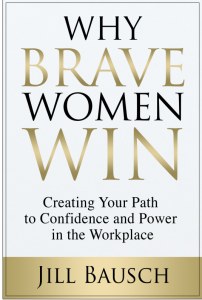By Jill Bausch, above, former CEO of Futures Group Europe, a coach, philanthropic strategist, facilitator, social impact adviser and author of Why Brave Women Win
When I was asked to contribute to SME about the Winning Habits of Successful Women, I considered how many of these habits are not just for women but for everyone. Everyone has habitual routines. We might not consciously think about some of them, they come naturally. Others we consciously try to change or acquire, depending on the outcome we think we want. Think about your own habits as you read these winning habits and consider if you could adopt any of these to be a better business leader.
- THE “MORE OF/LESS OF” EXERCISE
When I had an in-office staff, before I began working from home, I frequently used the “more of, less of” exercise. It’s a great way to give and receive feedback that’s low-key and gentle. I find most people are naturally reluctant to give feedback, particularly feedback that could be construed as negative or critical. Conventional wisdom says see the good things first, and I agree, but this exercise replaces “What am I doing well?” and “What am I doing badly?” with “What do I want to see more of?” and “What do I want to see less of?” You will extract the same information but, psychologically, those terms are a lot easier for us to handle.
This process makes it very easy for me to see what my staff appreciate and what I should be doing to be a better manager and a better leader.
- Don’t be Afraid of FEEDBACK TO YOURSELF AND OTHERS
When it comes to adjustments, leaders need to get the feedback team members before they can provide new goals and tasks for improvement. In most cases, the only way a manager can provide effective feedback is to be among the team. A sports coach can’t provide productive feedback without seeing a player do his job. The feedback from the team member is as important as the feedback the manager provides. In fact, it is how the manager can fully understand the situation and make the right adjustment rather than just guess at what might solve a problem.
- PLAN MULTIPLE PATHS TO SUCCESS
The feedback exercise above is an example of a crucial conversation, and crucial dialogues require planning. Imagine the worst that can happen. Yes, that’s what I said, imagine the worst and plan how you will respond to that, because everything else that might happen will be a better outcome. After you make that plan, put it away and plan for a better-than-bad outcome. Then plan for the very best outcome you could have. How can you plan for those outcomes?
First, think through your crucial conversations before they happen. These are interactions of high stakes, differing views, and strong emotions.
Crucial conversations need the human connection so that the participants can see, hear, and judge voice tone and inflexion, body language, eye contact and demeanour. Information is generally transmitted by the words we use, but the interpretation of data is very much affected by body language. Are you about to have a crucial conversation? Don’t have it by text or WhatsApp, or even email. Prepare well by deciding the tone, possible outcomes and have alternatives to the potential outcomes.
- GET IN THE GAME
Many people have an unconscious, destructive habit. Either they ignore important issues, or they minimise or devalue things that are important to other people and, essentially, dismiss those things. Both are tactics used by people who fear contention and do their utmost to avoid it. This is another habit you should be looking for in yourself and proactively working to eliminate. Contention happens if life and pretending it doesn’t or avoiding it only makes it worse. As you get to know your teammates, it becomes easier to see their perspective and what you can do to accommodate their views without conflict. If you can, take the emotion out of the situation and concentrate on the facts.
In your scenario planning and in those crucial conversations, your head and your heart need to be focused on that conversation, its origins, processes, and ramifications. A crucial conversation requires commitment in preparation and execution, so really show up, tune in and slow down.
- SEE THE DIFFERENCES IN WHAT MOTIVATES TEAM MEMBERS
We hear this term a lot, but what, precisely, is “motivation”? Among its synonyms are catalyst, desire, drive, hunger, inducement, persuasion, spur, wish. Some like to call it the “fire in the belly.” If you can help your team keep that fire you push to get your best outcome. No quiet quitting here. Real motivation is the internal feeling that pushes us to achieve whatever it is that we’re after. Those achievements naturally make us feel more competent (and, therefore, less prone to imposter syndrome), less prone to stress in general, and they reduce our hesitation to take on future projects.
When you are questioning motivation, learn to say to your staff, “What can we do with that to get you motivated? Can we break it up, divide those projects into smaller pieces and share them with others?” or “Can we find a part of it that you would enjoy the task? Would that encourage you enough to take it on with some measure of enthusiasm?”
- ASSUME THE RIGHT TO MIRROR CONFIDENCE
Assume means both “to take for granted or without proof” and “to take upon oneself.” Assuming the right to mirror confidence does both. As a leadership coach, many people privately tell me they are lacking confidence. I ask them who their role models are and to describe what they are like, how they seem, what they admire about that role-model.
Assuming the right to mirror confidence and, ultimately, to be confident, is the path to success. It is, in a real sense, the victory. So, whip through this four-point plan:
- Think about how your role model shows confidence and ask yourself, “How would s/he handle this situation?”
- Mirror the actions your role model shows: the speech, the cadence, the body language, the demeanour and really think, what is this person doing that I would like to emulate?
- Respond to others as if you already have the confidence you seek.
- Repeat this cycle until the act becomes a habit, second nature, an automatic response to any situation.
You might ask me, as many have, if I do that am I faking it to make it? No, you’re mirroring someone you admire until you become the confident individual you should be— the act becomes the persona. You win.
- BE A ROLE MODEL FOR OTHER WOMEN (and Men, do it for other men)
This is probably something you may be before you even know you are. It may be that it happened naturally, organically, spontaneously or by practicing these habits. Other women will eventually see you as you’ve seen your own role models and they will mirror you as you mirrored those who went before.
In many cases, it will be something you do, how you seem, your demeaner or how you react to stressful situations:
- Look around you, see who needs coaching or mentoring or just a little encouragement.
- Adopt some high-potential staff and some obvious strugglers as protégés.
- Coach and mentor them, by example and by educating them in how the system works.
- Encourage them to pass on the gift by being role models for those who follow them.
We learn, usually by trial and error, how to create the most perfect-as-possible blend of personalities and talents to accomplish great things. Let those that came before you set the path and contribute to it to leave your own legacy for leadership.


